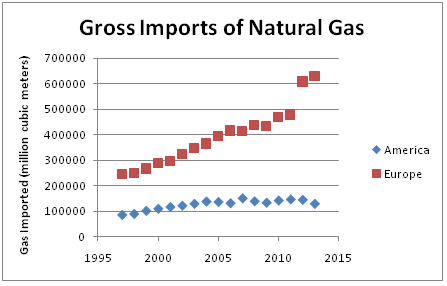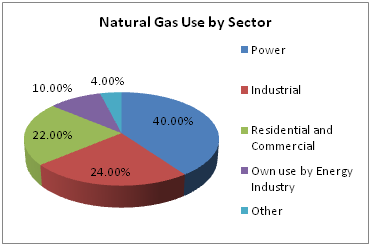In recent years, natural gas has been recognized as the invaluable energy resource, and its reliance as a fuel source has grown ever since. In order to explain how a GTCC power plant works, we must first explain what natural gas is and why it is important.
Natural gas is a combination of many chemical compounds which releases a large amount of energy when burned. It can generate much more energy per unit mass and nearly as much energy per unit volume than coal can generate. From an emission stand point it has less types of chemical wastes than coal. Rubin tells us that at Standard Temperature and Pressure, natural gas has a heating value of 53.2 MJ/kg, or 38.2 MJ per cubic meter. For comparison, according to Supple the highest quality of coal has a heating value of 30 MJ/kg, or 39.6 MJ per cubic meter.
As shown in the figure above, natural gas is mainly used in power, industrial, and residential applications. GTCC power plants have a higher efficiency, which allows less fuel to be burned to meet current energy demands. Future advances and implementation can reduce our dependence on a diminishing supply of natural gas.

January 2014. Web. Accessed 15 April 2014.
The figure above shows that natural gas imports and exports are increasing in the Europe while holding steady in the United States. This shows the need for a lower consuming method of power generation, and importance of efficient GTCC power plants.
Natural gas is not just some “miracle fuel” whose potential usefulness is impaired by a lack of technology and distribution to implement it. Nor is natural gas a fuel which we are in imminent danger of running out of. According to the International Energy Association (IEA), international demand for natural gas in 2012 amounted to 3.427 billion cubic meters. However, the IEA also estimates that there are approximately 400,000 cubic meters of natural gas which can be extracted using conventional methods. Counting deposits of natural gas which are more difficult to extract, the IEA estimates that the global gas supply can last for 220 years at its current rate of consumption.
Resources:
Supple, D. Units and Conversions Fact Sheet. MIT Energy Club, 2007. Print.
FAQs: Natural Gas. International Energy Agency. Web. Accessed 15 April 2014.
Monthly gas data survey. International Energy Agency, January 2014. Web. Accessed 15 April 2014.
What is shale gas and why is it important?U.S. Energy Information Administration, 5 December 2012. Web. Accessed 12 April 2014.
Primary Author: Eric Gallant
Editor: Justin Sandler
